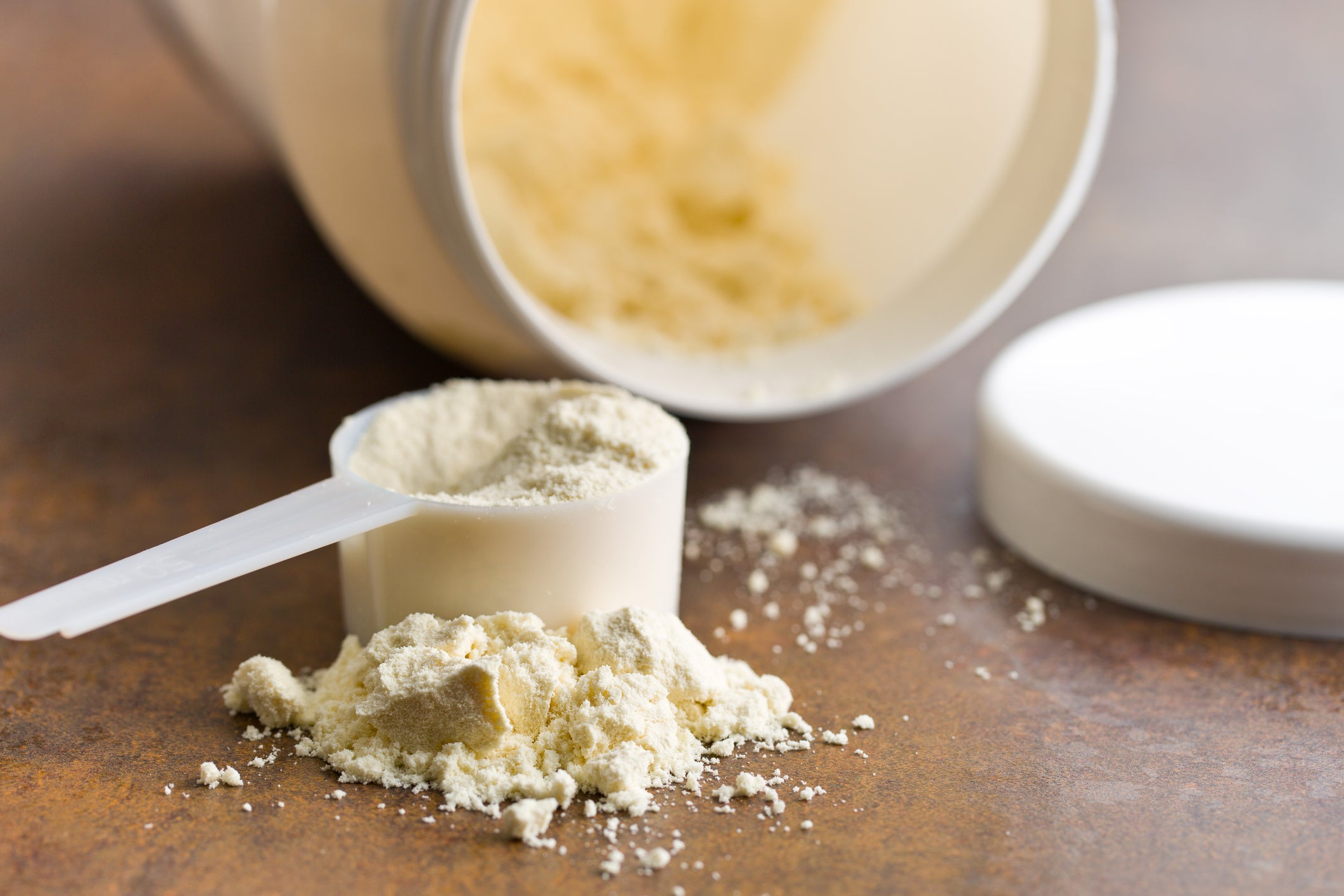The Independent's journalism is supported by our readers. When you purchase through links on our site, we may earn commission.
Experts reveal what to look for (and what to avoid) when buying whey protein powder
Wondering which whey protein powder to buy? Harry Bullmore asked the experts for their top shopping tips


Your support helps us to tell the story
From reproductive rights to climate change to Big Tech, The Independent is on the ground when the story is developing. Whether it's investigating the financials of Elon Musk's pro-Trump PAC or producing our latest documentary, 'The A Word', which shines a light on the American women fighting for reproductive rights, we know how important it is to parse out the facts from the messaging.
At such a critical moment in US history, we need reporters on the ground. Your donation allows us to keep sending journalists to speak to both sides of the story.
The Independent is trusted by Americans across the entire political spectrum. And unlike many other quality news outlets, we choose not to lock Americans out of our reporting and analysis with paywalls. We believe quality journalism should be available to everyone, paid for by those who can afford it.
Your support makes all the difference.The whey protein powder market is an overwhelming place nowadays. There are hundreds of options, with tubs covered in buzzwords and bright branding. But which protein powder, if any, should you buy?
This guide aims to serve as your supplement sommelier. I’ve enlisted the help of experts to identify which features you want from a quality protein powder, and which ones should trigger an about-turn.
Below, Prep Kitchen nutritional therapist Kerry Beeson and Holland and Barrett product developer Suria Darley decode some of the myths surrounding whey protein and provide a comprehensive buyer’s guide to help you find your next favourite product.
So, whether you’re using supplements to build muscle, support your weightlifting efforts or simply hit your daily protein quota around a busy lifestyle, consider their dos and don’ts before you buy.
What is whey protein?
Thanks to influencers and fitness models, protein powder has been somewhat glamourised. But the supplement has humble beginnings – it’s one of two dairy proteins and the liquid byproduct of the cheese-making process.
“Ever heard of curds and whey in cheese-making?” Darley says. “This whey contains protein, lactose and fats. It is filtered to concentrate the protein, separated, then dried to create the high-protein whey powder we see in our protein powders.”
The other dairy protein is casein. This is slower-digesting and can frequently be found as a pre-bed supplement, with the selling point of supporting muscle growth and repair overnight.
On the other hand, “whey protein is one of the most efficient, fast-absorbing proteins available, making it a great choice for athletes,” Beeson explains.
Read more: This one-move workout from Anne Hathaway’s trainer builds core stability in just three minutes
What are the types of whey protein?
Whey protein can be processed to take one of three main forms; concentrate, isolate and hydrolysate.
Whey concentrate: “Whey protein concentrate is lower in protein and higher in fat and carbs,” says Beeson. It’s the least processed form of whey protein, and as such it’s usually the cheapest. The difference in fat and carbs between whey protein concentrate and isolate also only tends to be a matter of grams, so recreational exercisers might want to stick with this more affordable choice.
Whey isolate: “Whey protein isolate has a higher protein content [than whey protein concentrate] with less fat and fewer carbs,” says Beeson. It also has a lower lactose content.
Whey hydrolysate: “Whey hydrolysate is pre-digested for faster absorption,” Beeson explains. This makes it a popular pick for a post-workout shake, but also means it’s usually more expensive.
Read more: Why going sober was one of the best things I’ve ever done
What are the benefits of whey protein?
Protein molecules are made from chains of amino acids, which can be used by the body as building blocks to repair and grow tissues. This includes muscle, hence protein’s brawny associations.
There are 20 amino acids in total, and the body needs all of them to function properly. It can make 11 of them, but the other nine need to be ingested, earning them the title “essential amino acids”. Any food, drink or supplement that contains all nine is called a “complete protein source” – whey protein falls under this umbrella.
“Whey protein provides all essential amino acids, including high levels of leucine, a key trigger for muscle protein synthesis [the process of building muscle],” Beeson says. “It may help with muscle repair, satiety, weight management and even immune function.”
Most official guidelines advise adults to eat roughly 0.8g of protein per 1kg of body weight. But FuelHub nutritionist Edward Mather told The Independent these figures on how much protein people should eat per day are “outdated”, particularly for active people.
Read more: I tried the 12-minute workout Helen Mirren's used for her ‘whole life’
“There is now a large body of evidence that shows the optimal range for an active healthy adult is anywhere between 1.6g and 2.5g of protein per kilogram of body mass each day,” he says. “Where you place yourself in this bracket will be determined by your goals, training and lifestyle."
If you can hit this figure with whole foods alone, there’s no need to splash the cash on extra protein supplements. But this can be tricky to do around a busy lifestyle, particularly for those looking to eat enough protein to support muscle growth.
“As protein is probably the most expensive macronutrient to source in the diet, protein powders can be a cost-effective and convenient way to boost protein intake,” Beeson says.
“Whey protein powder is quickly absorbed, which is why it’s loved by gym goers,” Darley adds. “It’s a simple way to get more protein into your diet, and you know exactly how much you’re consuming.”
However, both Darley and Beeson highlight how whey protein powder isn’t for everyone.
“As it's sourced from dairy, whey protein typically contains lactose which may cause digestive symptoms in sensitive people,” Beeson warns. “Some whey isolates have lactose removed, so they can be a better option.”
“Some people may experience bloating, gas, or discomfort,” adds Darley. “It’s also not suitable for those with a dairy allergy.”
What to look for when buying whey protein powder
Perhaps this is a case of teaching grandmother to suck eggs, but the first thing to look for when buying a protein powder is the protein content per serving. Beeson gives her seal of approval to anything between 20g and 30g.
The next thing to consider is cost. Don’t be drawn in by big-name athlete affiliations and bright branding – instead, deal in cold hard facts and recognised accreditations.
“The only extra thing worth paying for with a simple whey protein powder is that the product has been lab tested to ensure you’re getting what’s said on the tin,” says Darley.
One of the best labels to look out for when checking if a protein powder has been third-party tested is Informed Sport Certified. This shows that Informed Sport has checked the product is manufactured to a high standard and doesn’t contain any prohibited substances.
Beyond protein content and lab testing, you’ll also want a supplement that meets your individual needs. This includes picking a flavour you enjoy and considering any intolerances you may have.
“If you’re lactose-intolerant, choose lactose-free whey isolate,” Beeson advises. Vegan protein powders can be another option here. “For everyday use, a concentrate might be more cost-effective. Ideally, you should choose a product with minimal added sugars or fillers, and watch out for proprietary blends, which often hide ingredient amounts.
“Also think about whether you need to accommodate dietary preferences such as halal, soy or gluten-free products. If you take other supplements, make sure you check to see if your powder contains added vitamins or minerals.”
What to avoid when buying whey protein powder
Both Beeson and Darley identified the same red flag when shopping for protein powder: outlandish claims.
“I’d avoid any company that makes over-the-top claims without evidence,” Darley says. “Transparency of dosages of each ingredient is essential. Our TriActive range declares all ingredient levels as they are at the efficacious level – that is, [a level that’s] clinically studied and proven to work.”
“If a protein powder claims to do everything, it probably does nothing well,” Beeson adds. “Key red flags include proprietary blends that hide ingredient dosages, excessive sugar content (more than 3g to 4g per serving) and a lack of third-party testing.
“There have been cases where protein powders were contaminated with heavy metals, so always choose a reputable brand. Energy-boosting claims should also be scrutinised. If a protein powder is loaded with caffeine, ask yourself, do you want nourishing recovery fuel or a glorified energy drink?”
Common whey protein ingredients and what they mean
To stand out in a crowded market, many whey protein powders are now fortified with extra ingredients, and brands claim they can deliver bonus benefits. Below you will find a list of the most common added ingredients, what they do, and whether they’re worth your time:
Creatine: “Creatine is a great ingredient to have alongside your gym routine,” says Darley. Supplementing it can boost phosphocreatine stores in your cells. Phosphocreatine is used to produce adenosine triphosphate (ATP), which is an easy-access energy source for your muscles – ideal for high-intensity bursts of activity like jumping, sprinting or lifting heavy weights. “If creatine is part of your protein powder, ensure you are getting at least 5g, however for muscle building I’d recommend buying this [supplement] separately,” Darley adds.
BCAAs: “BCAAs are branched-chain amino acids, with research suggesting they aid muscle recovery,” Darley says. The name comes from their chemical structure, and they represent three of the nine essential amino acids the body needs to consume. “However, whey is a complete protein source [it contains all nine essential amino acids] so these aren’t necessary in a whey protein.”
Artificial sweeteners: “Sweeteners such as sucralose, stevia and acesulfame-K improve taste without adding sugar, though you can find natural, unsweetened options,” Beeson says. “Flavourings and sweeteners are added because people often find plain whey protein unpleasant,” Darley adds. “It’s up to you whether you want a particular flavour or to consume artificial sweeteners.”
Emulsifiers: “Emulsifiers are ingredients designed to enhance the overall performance and convenience of the product, like soy or sunflower lecithin,” says Beeson. “They prevent clumping [by helping the powder mix], ensuring a smooth shake.”
Anti-caking agent: “Anti-caking agents prevent the powder from clumping after you’ve opened it,” Darley says. One of the most common is silicon dioxide.
Other: “There may also be preservatives and fillers like maltodextrin in protein powders, which bulk out the product and make it cheaper to produce but reduce the overall nutritional value,” Beeson explains. “If you prefer to choose additive-free powders, you can find ‘cleaner’ cold-filtered powders from organic, grass-fed dairy cows which are free from additives and chemicals, and contain beneficial essential omega-3 fats.”
Whey protein powder summary
If you want a quality whey protein powder, there are a few things to look out for and one key point to avoid, according to our experts. First, choose a powder that has 20g or more of protein per serving. Ideally, you’ll also want a product that has been third-party tested, ensuring it is manufactured to a high standard and doesn’t contain any banned substances.
A short, recognisable ingredients list is preferable, with “minimal added sugars [less than 4g per serving] or fillers”. Both Darley and Beeson also advise avoiding tubs plastered with larger-than-life, unsubstantiated claims.
Read more: I walked 10,000 steps with a weighted backpack every day for a week – here are five reasons I’m not stopping




Join our commenting forum
Join thought-provoking conversations, follow other Independent readers and see their replies
Comments